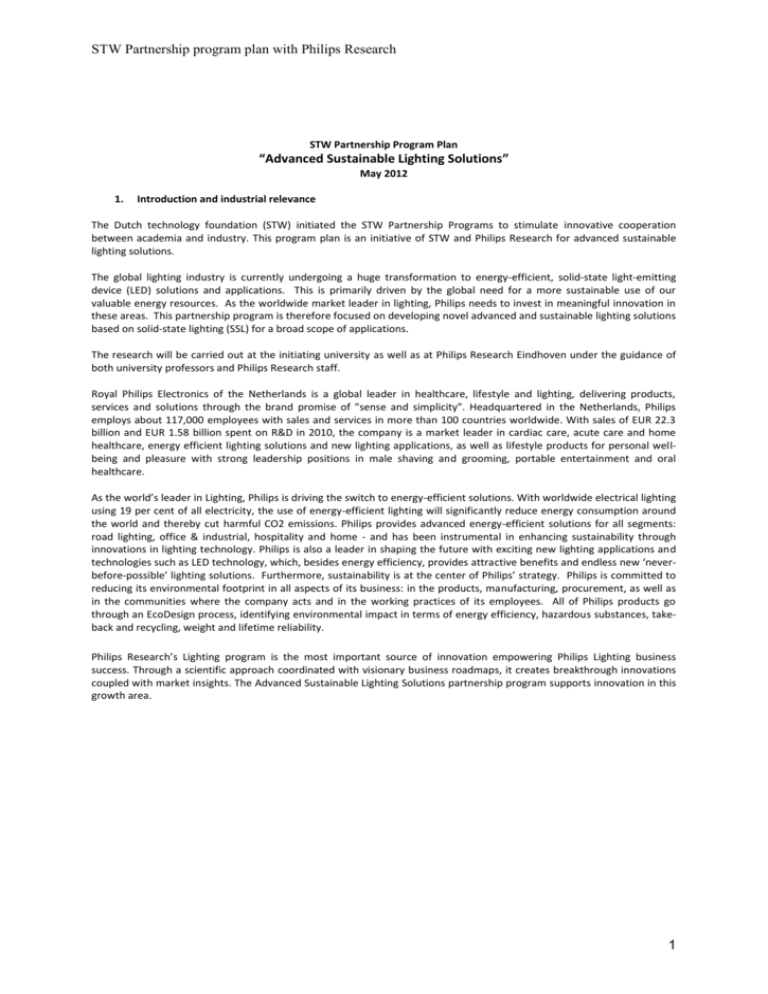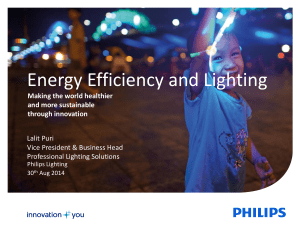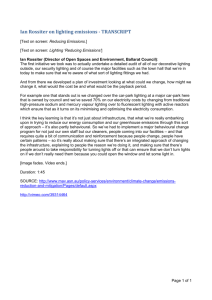Format Partnership Programme Plan
advertisement

STW Partnership program plan with Philips Research STW Partnership Program Plan “Advanced Sustainable Lighting Solutions” May 2012 1. Introduction and industrial relevance The Dutch technology foundation (STW) initiated the STW Partnership Programs to stimulate innovative cooperation between academia and industry. This program plan is an initiative of STW and Philips Research for advanced sustainable lighting solutions. The global lighting industry is currently undergoing a huge transformation to energy-efficient, solid-state light-emitting device (LED) solutions and applications. This is primarily driven by the global need for a more sustainable use of our valuable energy resources. As the worldwide market leader in lighting, Philips needs to invest in meaningful innovation in these areas. This partnership program is therefore focused on developing novel advanced and sustainable lighting solutions based on solid-state lighting (SSL) for a broad scope of applications. The research will be carried out at the initiating university as well as at Philips Research Eindhoven under the guidance of both university professors and Philips Research staff. Royal Philips Electronics of the Netherlands is a global leader in healthcare, lifestyle and lighting, delivering products, services and solutions through the brand promise of "sense and simplicity". Headquartered in the Netherlands, Philips employs about 117,000 employees with sales and services in more than 100 countries worldwide. With sales of EUR 22.3 billion and EUR 1.58 billion spent on R&D in 2010, the company is a market leader in cardiac care, acute care and home healthcare, energy efficient lighting solutions and new lighting applications, as well as lifestyle products for personal wellbeing and pleasure with strong leadership positions in male shaving and grooming, portable entertainment and oral healthcare. As the world’s leader in Lighting, Philips is driving the switch to energy-efficient solutions. With worldwide electrical lighting using 19 per cent of all electricity, the use of energy-efficient lighting will significantly reduce energy consumption around the world and thereby cut harmful CO2 emissions. Philips provides advanced energy-efficient solutions for all segments: road lighting, office & industrial, hospitality and home - and has been instrumental in enhancing sustainability through innovations in lighting technology. Philips is also a leader in shaping the future with exciting new lighting applications and technologies such as LED technology, which, besides energy efficiency, provides attractive benefits and endless new ‘neverbefore-possible’ lighting solutions. Furthermore, sustainability is at the center of Philips’ strategy. Philips is committed to reducing its environmental footprint in all aspects of its business: in the products, manufacturing, procurement, as well as in the communities where the company acts and in the working practices of its employees. All of Philips products go through an EcoDesign process, identifying environmental impact in terms of energy efficiency, hazardous substances, takeback and recycling, weight and lifetime reliability. Philips Research’s Lighting program is the most important source of innovation empowering Philips Lighting business success. Through a scientific approach coordinated with visionary business roadmaps, it creates breakthrough innovations coupled with market insights. The Advanced Sustainable Lighting Solutions partnership program supports innovation in this growth area. 1 STW Partnership program plan with Philips Research 2. Focus, objectives and applications Focus The Advanced Sustainable Lighting Solutions program is about creating novel solutions for high-quality, efficient lighting for a wide variety of applications. Taking general lighting into account, it is important to note that modern societies need a lot of light. With the urbanization of the emerging markets on the one side and with the increasing shift to a global 24/7 economy on the other side, the demand for lighting is expected to increase by a factor of 2.9 by 2050. Only by adoption of very high-efficient, appealing and cost-competitive solid-state lighting solutions to decrease energy usage will it be possible to produce more light in a sustainable way. Furthermore, as commoditization of the “standard” LED element happens and a shift to Far East production sites occurs, the Netherlands must already begin to plan ahead and identify both routes to higher-efficiency lighting elements and modules for appealing luminaires, and new applications for lighting technologies. Objectives and applications Together, STW and Philips Research are looking for knowledge and innovative solutions that help to realize this vision. LEDs and luminaires Recent advances in solid state lighting hold the promise of far more energy-efficient LED lighting sources than are presently available. While incremental improvements in materials growth and device structures are being pursued, there is also a need to explore new avenues to reach ultimate LED device efficiencies. These proposed ultimate LED device efficiencies should be 260-280 lm/W, assuming that the internal quantum efficiency, extraction and electrical efficiencies are ~90% for all primary colors. For example, for the primary colors, green-amber-red LED research requires a breakthrough in efficiency, which might require research on strain engineering, quantum dot based systems or non-nitride emitters. Furthermore, optical, thermal, mechanical, electrical and perception aspects must be taken into account if a practical and consumer-acceptable optimized LED module and luminaire is to be developed. This research could include diffractive optics design, free-form, arbitrarily-shaped luminaires and corresponding materials, novel drivers as well as improved understanding of human visual perception of LED luminaires. Applications The use of lighting technology to target applications beyond general illumination is the objective of this research focus. Current LED research is focused on incremental higher energy efficiency and labors with adoption issues for general illumination; however, there remains an enormous area of lighting application research which requires technology to be introduced, characterized, and validated in other relevant environments. To develop optimized lighting solutions ranging from consumer applications to healthcare environments to horticulture use, solutions based on novel, specialized LED lighting will need to be developed. These lighting systems, which meet (for example) specific spectral and brightness characteristics, must be shown to perform as intended, or to have their claim validated for a particular application. This application effort can also be understood as a parallel activity to LED device and module development, where novel LEDs and systems can be designed to meet the specifications of different applications. This will support lighting penetration into new markets of relevance where advanced claim knowledge and matched specialized lighting availability will be paramount. Sustainability The participants of this program may also focus on the contribution of lighting technologies towards sustainability, beyond the obvious impact of increased energy efficiency. We believe that lighting technology and system solutions can be proposed to address the issue of our planet’s limited resources, and as such projects to support this are welcome. 2 STW Partnership program plan with Philips Research Major Research Areas The Advanced Sustainable Lighting Solutions program therefore targets progress in three research areas: LED materials, devices and modules; i.e., the maximization of high-quality and efficient light output from LED luminaires, to ensure maximum IQE, extraction and electrical efficiency of LED light sources. To this end, novel materials and device proof-of-concepts, for maximizing the output of the SSL luminaire as well as novel optics, drivers, controllers, and other essential components of the LED module are welcome. Lighting applications, or solutions with LEDs for improved illumination, perception, health, materials processing, hygiene, plant growth, sustainability, and more. What is being sought are ideas for the use of lighting technologies to stimulate novel applications; e.g., in aspects of human health (phototherapy, wound healing, vitamin D generation, …) including clinical proof of the therapeutic/healing effects, or for horticulture applications where specialized and tuned lighting systems could provide enhanced plant, animal and food growth. Similarly, a better fundamental understanding of the interaction of light (spectra/brightness) to generate a particular result which can be validated is needed. Sustainability; where aspects beyond energy efficiency of solid-state lighting solutions are addressed. This can include methods for inspiring new behaviors around lighting with respect to sustainability, or business models to improve takeback and cradle-to-cradle concepts. Similarly, business models and technological solutions to bring light to people who lack lighting are welcome. We expect these research themes to be addressed by universities with specialized materials and devices knowledge, those with specific experience in perception, health and hygiene, agriculture and air and water purification, and those with some technology and business model knowledge. Clearly, there will be overlap between these three themes, which will be encouraged wherever possible. As an industrial company, we aim at deliverables in the form of proof-of-concept devices, prototypes, models, innovation in services and business models, and testbeds for application demonstration and validation, in addition to the expected publications and dissertations. We anticipate a close relationship with experienced university professors and students, resulting in shared knowledge and experience leading to new products and application-driven businesses in the Netherlands. 3. Scientific challenges Scientific challenges of industrial interest in the aforementioned research themes focus upon: 1. Novel materials and devices proof-of-concepts, for maximizing the output of the SSL luminaire. This can include: a. Methods to achieve ultimate LED efficiencies. b. quantum dot materials for efficient light emission, c. graphene or other novel materials for optical devices, or for improved thermal / electronic properties, d. organic nanophotonics, including OLED (organic-light-emitting device) physics and organic phosphors, e. nanostructured LED emitters, f. LED-pumped lasers, g. novel, compact optics and simulations for controlled 2D/3D LED distributions, h. diffractive optics design and fabrication, i. free-form luminaire design methods, including new integration methods of LEDs on surfaces, j. materials for optimized electrical, thermal, optical and mechanical behavior for flexible large-area lighting, k. photonic crystals for maximizing LED output and beamsteering, l. high-temperature LED drivers and novel interconnect technologies which allow higher temperature operation of the LED module (for maximizing efficiency), m. methods to understand and predict critical failure modes of LEDs. 2. Applications for lighting systems for challenges beyond general illumination. a. Lighting for better hygienic surfaces in hospital environments through tuned spectra, b. enhanced plant, animal and food growth with specialized lighting, c. improved fundamental understanding of the interaction of light with the human body, brain and mind, animals and plants for improved growth, and more. 3 STW Partnership program plan with Philips Research d. e. f. g. 3. A part of this research could include novel sensing where required, user interaction studies, and ambience creation and perception. Research to lead to perceived higher-quality light perceived in various environments (office, home, etc.) to improve concentration, well-being or health, light for phototherapy solutions such as wound healing or pain management, including sensor and actuator systems for monitoring and treatment, Spatio-temporal perception of light for “comfortable lighting” for glare reduction and enhanced rendering Lighting for sustainability, beyond the aspect of increased energy efficiency. a. Behavioral change inspired by lighting system features, novel services or business models, e.g., for improved takeback of lighting devices, b. bringing light to people who today still lack light to extend their day (or more generally: how can lighting contribute to increasing the human development index in regions where this is still very low) c. intense interaction of lighting systems with other indoor/outdoor systems to improve overall effectiveness and serve multiple stakeholders in a balanced way d. using resources responsively (re-use, cradle-to-cradle concepts). Combinations of these three research areas are also welcome. 4. Fit of research proposals into the program Research project proposals are expected: To indicate which of the three research themes will be addressed. For the application research, we encourage cooperation between different faculties to address the application in a holistic manner. Similarly, testbedding and validation of application research “in the field” is encouraged, and proposals which address how studies are to be done on location are welcome. To include a stay at Philips Research to make the connection to the Philips Research community in lighting-related research. To include an evaluation of the impact of the research for the target customer. Research proposals are encouraged: To indicate a clear benefit by close cooperation with Philips Research or the High Tech Campus, Eindhoven; For LED research, to deliver proof-of-concept results and not solely simulations and modeling, and To address the time horizon of the proposed research solution vis-à-vis the highly dynamic nature of the LED business; For application research, to collaborate with organizations active in horticulture, institutional healthcare, education, psychology, mental and physical (sport) training, or other, where a fundamental understanding of the application area is required; To indicate, where possible, the links to existing research networks which can be leveraged upon. Outside of the scope of the program are project proposals that: Aim specifically at improvement of epitaxial growth or design of quantum well structures for maximization of LED efficiencies; Provide ‘advanced’ solutions which will not deliver efficiencies comparable to existing solutions; Aim to develop new networking or sensor technologies; Require sensor technologies that are too expensive, or hard to install or calibrate; Do research and development on the basis of patents that are not owned by either the university applicants themselves or by Philips. 4 STW Partnership program plan with Philips Research 5. Unique character of the program The program is highly ambitious: development of materials, devices and systems for applications touching many societal needs. Clearly energy efficiency is a primary target, but also applications for better health and well-being are welcome. Philips seeks a long-term university relationship in areas of strategic lighting research interest, leading to an improved competitive advantage for Philips Lighting based on scientific innovation as well as a source of superior research staff members for Philips Research. We expect that this partnership program will also support the excellent competitive position of the Netherlands in materials, devices, systems and applications research, and build new export businesses in applications beyond lighting systems – such as in agriculture, health, and air/water purification. We expect submissions from the technical universities (Eindhoven, Delft) as well as the universities of Utrecht, Leiden, Nijmegen, Maastricht, Tilburg, Wageningen (WUR), Groningen (RUG), Twente, and Amsterdam. The STW partnership instrument is expected to provide us with the possibility to define a coherent research program on this topic in the Netherlands. The high-level research competences required to ensure retention of market leadership through innovation during the SSL revolution are scarce. At Philips Research, there is and will be in the future a need for research staff with a physical sciences and engineering background. With this fact in mind, it is clear that investment in universities and research institutes must be done to overcome the current scarcity, as well as to provide a pool of technical staff for future employment at Philips. From Philips Research side, the partnership program will be executed in the existing context of the Philips Research industrial PhD and Post Docs program (“Van der Pol Program”). 6. Duration and budget The proposed duration of the program is 5 years, the budget is 3M€ funded on a fifty-fifty basis by STW and Philips Research. 7. Program Committee The program will be managed by a program committee (PC) consisting of four persons: Two members from Philips Research and two members nominated by STW. The members of the PC have skills and expert knowledge appropriate to assess the proposals and have a high level and recognition of experience in the particular field. PC members may invite other advisory members to the PC meetings, although these will not have any voting rights. The PC is responsible for the overall directions and management of the program. PC meetings will be organized/planned twice a year unless the PC decides differently based on needs. STW shall appoint a Secretary to the PC who shall not have voting rights but will assist regarding administration/organization. The secretary and the auditor will not be funded from the project. All members of the PC will sign a NDA to protect any ideas laid down in the university project proposals. Philips Research expert candidates: 1. 2. Dr. Eliav I. Haskal, Director Lighting Strategic Partnerships, Philips Group Innovation, Research Dr. Sjoerd Mentink, Innovation Area Manager, Philips Group Innovation, Research STW scientific expert candidates: 3. 4. … … 8. Special conditions for applicants Universities and Institutions that qualify for STW criteria can apply. 5






